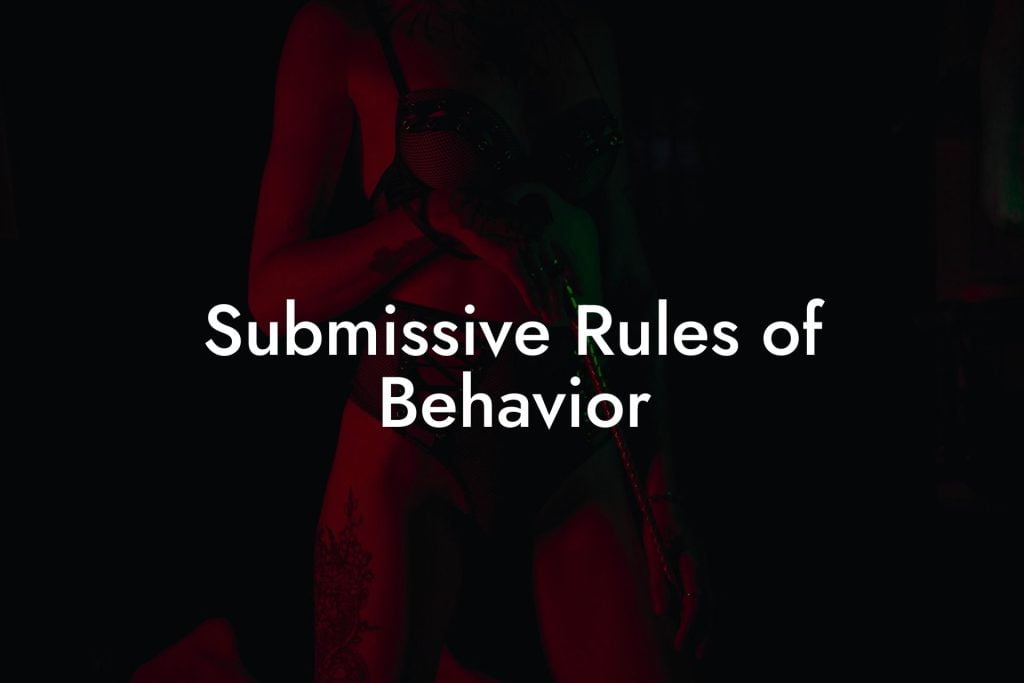BDSM, short for bondage, dominance, submission, and masochism, is a lifestyle that has gained immense popularity in recent years. It offers a thrilling way to explore power dynamics, intensify pleasure, and strengthen relationships. However, engaging in BDSM requires knowledge and understanding of its fundamental rules. In this article, we will delve into the essential rules for BDSM, providing you with a comprehensive guide to navigate this exciting realm.
In any BDSM relationship, consent is the cornerstone of trust and respect. It’s more than just saying “yes” or “no”—it’s about openly communicating your desires, limits, and expectations. But trust doesn’t end with a conversation—it’s built through ongoing, clear agreements. That’s where our Dominant & Submissive BDSM Contract Pack comes in. Find out more →
Consensuality
The cornerstone of BDSM is consent. Each participant involved must provide explicit and enthusiastic consent for any activity. This ensures that all parties involved are willing and comfortable throughout the experience. Communication plays a vital role here, allowing individuals to express their desires, limits, and boundaries.
Safe Words
Safe words are an integral part of BDSM play. These special words or signals are mutually agreed upon and act as a way to communicate boundaries, discomfort, or the need to pause or stop an activity. Safe words should be clear, easily remembered, and straightforward, such as "red" to halt all activity and "yellow" to take a break or proceed with caution.
Research
Engaging in BDSM requires a solid understanding of the various practices, techniques, and safety measures involved. Take the time to educate yourself through reliable sources, workshops, books, or online communities. Knowing the correct techniques and having a sound knowledge base will help ensure a safe and enjoyable experience.
Negotiation
Before embarking on any BDSM scene or play, negotiation is vital. Discussing limits, boundaries, and desires allows each participant to express their individual needs, expectations, and comfort levels. Take the time to have open conversations surrounding desires, hard limits, and soft limits. This negotiation process helps establish consent and creates a mutually agreed-upon framework for exploration.
Looking for the best BDSM & Kink OnlyFans content creators? Here is a list of 10 of our favourites:
- Best Cosplay OnlyFans - 🐱 Little Kitty Kate 👉👌 >> Link
- Best Little OnlyFans - 🧸 Katya 🙇♀️ Sun >> Link
- Best Sub OnlyFans - 🍌Hanna Banana🍌 >> Link
- Best Teen & Huge Tits OnlyFans - ❣️Anny❣️19 y.o. BUSTY student girl >> Link
- Best Tiny Tits OnlyFans - ⍣⭐️ Sofia Parker ⭐️⍣ >> Link
- Best Sub & Huge Boobs OnlyFans - Nika Huge Boobs >> Link
- Best Kink OnlyFans - Julia Pearl🐚 >> Link
- Best Fetish & Girl Next Door OnlyFans - Hillary is Wet 💦 >> Link
- Best Dirty Latina OnlyFans - Paula Flores 😈 >> Link
- Best BBW & Huge Ass OnlyFans - Naughty Hanna Zimmer 💜🎀 >> Link
Not quite what you are looking for? View the full list →
Safety Measures
Implementing safety measures is essential to ensure a risk-aware and consensual environment. This may include using safe and appropriate equipment, such as restraints, paddles, or blindfolds, as well as following guidelines for proper hygiene and aftercare. Educate yourself on proper techniques and safety precautions to prevent any unnecessary risk or harm.
Frequently Asked Questions
What is a BDSM contract?
A BDSM contract is a formal agreement between consenting adults outlining the practices, boundaries, roles, and responsibilities within a BDSM relationship. These contracts help establish rules and expectations, ensuring that all parties understand and consent to the activities that will take place.
Are BDSM contracts legally binding?
In most jurisdictions, BDSM contracts are not considered legally binding agreements. They are more symbolic, serving to establish trust and communication between the parties involved, rather than a document enforceable by law.
What should be included in a BDSM contract?
The specifics of a BDSM contract can vary, but generally, they should include terms of consent, safewords, limits (hard and soft), roles, duration of the agreement, confidentiality clauses, and any specific rules or protocols that will be observed by the parties.
How do power dynamics work in a BDSM relationship?
Power dynamics in BDSM involve a consensual exchange of power where one person (the Dominant) takes on a more controlling role, while the other person (the Submissive) agrees to yield control. These roles are defined and agreed upon in advance and are a core part of the relationship's structure.
Why are consent and negotiation important in BDSM?
Consent and negotiation are the foundations of BDSM. They ensure that every participant has a clear understanding of what will happen and has explicitly agreed to it. This process helps prevent misunderstandings, reduces the risk of harm, and ensures that the activities are enjoyed by all parties.
What are 'safewords' in BDSM?
Safewords are words or signals used in BDSM to communicate the need to slow down, adjust, or stop the scene entirely. They are safety measures that ensure the well-being of all parties and are an essential aspect of the communication and trust within a BDSM relationship.
How can you ensure safety in BDSM activities?
Safety in BDSM can be ensured by following key practices: openly communicating boundaries and limits, using safewords, being aware of each other's physical and emotional state, and having mutual trust and respect. It's also crucial to educate oneself about the practices and to use common sense and safety equipment as necessary.
What if my boundaries are crossed during a scene?
If your boundaries are crossed during a scene, it's important to communicate this immediately, using your safeword if necessary. After the scene, discuss what happened with your partner in a non-judgmental manner to understand why the boundary was crossed and how to prevent it from happening again.
How do you discuss consent and boundaries with a BDSM partner?
Discussing consent and boundaries with a BDSM partner involves open and honest communication, where all parties feel comfortable sharing their desires, limits, and expectations. This conversation should occur before engaging in any activities and be revisited regularly to ensure ongoing consent.
Can safewords still be used when practicing 'consensual non-consent'?
Yes, safewords are crucial even in 'consensual non-consent' scenarios, where the fantasy involves acting as if consent is not present. Safewords allow all participants to have an emergency exit if the scene becomes too intense or if boundaries are inadvertently crossed.
What is aftercare in BDSM, and why is it important?
Aftercare refers to the time partners spend together after a BDSM scene to recover and reconnect emotionally. It can involve physical caring, such as cuddling or tending to any marks or bruises, as well as emotional support. Aftercare is crucial as it helps in preventing sub-drop and Dom-drop and reinforces the bond and trust between partners.
Is it necessary to renegotiate a BDSM contract?
Yes, renegotiating a BDSM contract is common and necessary as relationships evolve and individuals learn more about their preferences and limits. Regular renegotiation ensures that the contract remains relevant and consensual for all parties involved.
Can a BDSM contract have an expiration date?
A BDSM contract can include an expiration date if the parties agree. This allows both partners to reassess the relationship and the terms of the contract periodically before deciding whether to extend, modify, or terminate the agreement.
Is trust more important in BDSM than in other types of relationships?
Trust is a crucial element in all relationships, but in BDSM, where activities can involve vulnerability and power exchange, trust becomes even more central. It is the key to allowing the relationship to flourish in a way that is safe, consensual, and fulfilling for all parties.
Are there any risks associated with BDSM activities?
Like any physical activity, BDSM activities carry inherent risks. These can range from minor injuries to more significant psychological effects if not conducted responsibly. Understanding the risks, communicating clearly, and trusting your partner are essential steps to mitigate these dangers.
How can beginners ensure they are practicing BDSM safely?
Beginners should start slowly, take time to research and learn about BDSM practices, communicate extensively with their partners, establish clear safewords and boundaries, and possibly seek guidance from the BDSM community through educational resources and workshops.
What does 'RACK' stand for, and why is it important?
'RACK' stands for Risk Aware Consensual Kink. It is an acronym used to highlight the importance of being informed about the potential risks involved in BDSM activities and ensuring that all actions are consensual. It emphasizes personal responsibility for the risks taken by all parties involved.
Can someone revoke consent during a BDSM scene?
Absolutely. Consent is ongoing and can be revoked or modified at any time during a BDSM scene. It is vital that all parties respect the withdrawal of consent immediately and cease any activities that go against it.
What is 'sub-drop' and 'Dom-drop'?
'Sub-drop' refers to the psychological and physical come-down that a submissive may experience after a BDSM scene. 'Dom-drop' is the equivalent for Dominants. Both conditions are characterized by feelings of sadness, exhaustion, or emptiness, and can occur immediately or several days after a scene. They emphasize the need for proper aftercare and support.
How does one approach the establishment of protocols in a D/s relationship?
Establishing protocols in a D/s (Dominant/submissive) relationship involves discussing and agreeing upon specific behaviors, rituals, and rules that reinforce the power dynamic. This should be done with careful communication, taking into account the needs, desires, and limits of both parties.
Is a BDSM lifestyle something that is always 'on', or can it be 'on' only during scenes?
BDSM lifestyles can vary greatly from person to person. For some, it may permeate all aspects of their lives, while for others, it is confined to specific scenes or situations. It's a personal choice and should be discussed and defined by the individuals involved in the relationship.
Now that you are familiar with the essential rules for BDSM, you are ready to embark on your journey with confidence. Remember to prioritize consent, communication, and safety while exploring the diverse world of BDSM. If you crave more knowledge and guidance, visit Filthy Adult for our Ultimate BDSM Contract Pack, additional comprehensive guides, and a wide range of BDSM essentials in our online fetish shop. Don't forget to share this article with others who may benefit from this valuable resource. Happy exploring!













